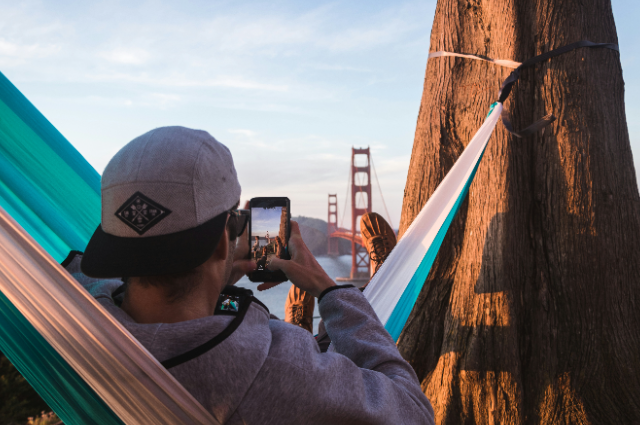
Photo by Michael Henry on Unsplash
ABSTRACT
In today's world, where friends, family and even strangers are connected through social platforms are just a click away. Social media undeniably has become a part of our daily lives. But have we ever pondered how social media is influencing travel trends sparked by digital platforms? As we step into 2024 the impact of social media on the travel industry continues to evolve. Their impact goes far beyond sharing travel content. Post-sharing can impact tourism either in a positive or negative way.
INTRODUCTION
In the not-so-distant past, the tourism industry relied on tourism marketing channels like T.V., print media and travel agencies. However, nowadays tourists mostly rely on social sites. The impact of social media can be seen in many ways from sharing breathtaking pictures to residing in luxury hotels or resorts to exploring unique destinations. Social media platforms have transformed the way we plan, travel, experience and be nostalgic about our journey.
HOW DOES SOCIAL MEDIA ARISE IN THE TOURISM INDUSTRY?
With a myriad of new social media platforms, advanced technology and changing consumer patterns, the landscape of travel has undergone a significant transformation. The new advent of social platforms like Instagram, Twitter, and Facebook are all emerging as the go-to platforms for discovering new travel destinations, hidden gems and unexplored places. Influencers and content creators wield major influence in shaping travel trends. Through visually attractive posts and videos of destinations, cuisine delights, accommodation, cultural experiences and adventure activities,, inspiring millions to embark on a similar journey. Social media's evolution continues to impact the tourism industry significantly.
IMPACTS OF SOCIAL MEDIA ON TOURISM
Now, let us delve into the impacts that social media has brought to the tourism industry. From increased exposure and tourist engagement to the power of user-generated content, social media has transformed the way destinations are marketed and experienced. Let's talk about the ways in which these factors have shaped the landscape of modern-day travel.
POSITIVE IMPACTS OF SOCIAL MEDIA ON TOURISM
- REACHING RIGHT AUDIENCE AND EXPOSURE - One of the most significant positive impacts of social media on the tourism industry is the unprecedented increase in exposure and reach. With billions of active users on platforms destinations can now effortlessly be shared through platforms and reached to the right audience.
- BOOKING TIPS THROUGH SOCIAL SITES - Social media streamlined the trip-planning process, enabling tourists to research, book and manage their itineraries seamlessly. The rise of travel-focused apps such as Make My Trip, Air BNB, and Booking.com has empowered users to access personalized recommendations. While sitting in one place customers can enjoy a booking experience at the easiest and fastest way to plan vacations.
- Sharing information and experiences - Social media serves as a virtual travelogue, allowing users to share their moments, travel tips and experiences to connect with travel enthusiasts. From posting eye-catching photos, videos and stories have the potential to go viral and attract immense attention. Through the use of location tags, accommodation tags and collaboration with travel influencers destinations can gain more visibility and attract the attention of the audience. The power of social media algorithms also plays a crucial role as engaging and relevant content is often prioritized and exposed to a broader audience.
As everything has pros, there are cons also. Tourism also has negative impacts due to social media. So, let us delve into the darker side of social media's influence on tourism.
NEGATIVE IMPACTS OF SOCIAL MEDIA ON TOURISM
- OVERTOURISM: Social media has undoubtedly amplified the visibility of destinations, it has also led to the exponential growth of tourist footfall, surpassing the carrying capacity of certain places. The unexplored are known through social platforms attracting hordes of travellers to explore such places leading to congestion and strain on local resources. Over-tourism leads to a decline in the quality of travel experience for both tourists and locals.
- Misinformation and negative reviews: While social media provides a platform for authenticity it also opens the door to the spread of false information. One negative feedback on social media regarding a destination can create a lasting impression on potential visitors, impacting a destination's tourism revenue. Tourists often visit sites prior to the journey for accommodation and sightseeing activities. Negative reviews and complaints can significantly influence a traveller's decision-making process.
- PRIVACY: One primary is the risk of privacy breaches. Travellers share personal information, location data and travel itineraries on social platforms. They inadvertently expose themselves to potential risks and threats. Geotagging features on social media posts can pinpoint a traveller's exact location potentially revealing their absence from home and making them susceptible to burglary. Additionally, public wi-fi often used by travellers can be vulnerable to cyber-attacks.
CONCLUSION
For the tourism industry, the age of billboards and brochures is over. At this point in time, the ties between social media and the tourism industry are inseparable. It is quite clear that the increasing influence of social media has significantly impacted the tourism industry, and this influence is continuing to grow in prominence. Social media platforms provide companies with the opportunity to establish direct relations with travellers.
